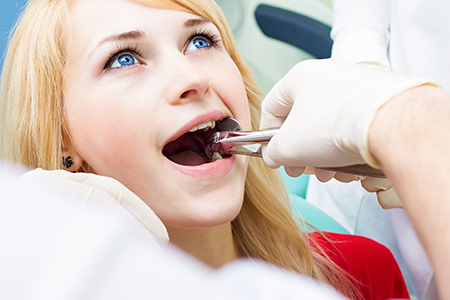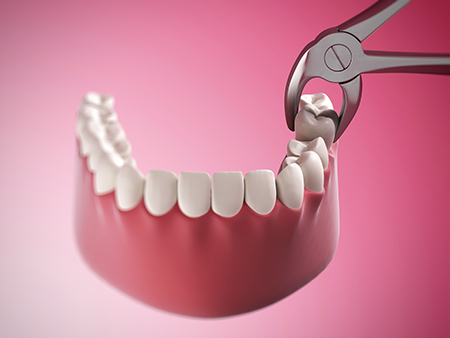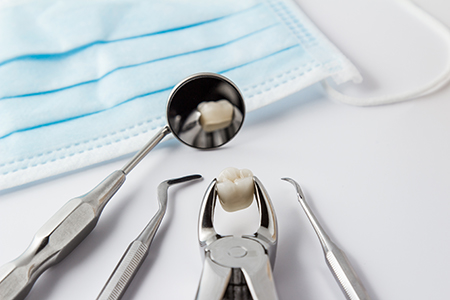Now Accepting Medicaid At All Locations!
Now Accepting Medicaid At All Locations!

Deciding to remove a tooth is rarely taken lightly. Our primary goal is always to preserve natural teeth whenever possible, but there are clear situations where extraction protects your overall oral health. This page explains why a tooth may need to be removed, what happens before and during the appointment, and how to recover safely afterward.
We tailor every recommendation to the individual—taking into account your medical history, current symptoms, and long-term goals for function and appearance. New Day Dentistry approaches extractions with a focus on comfort, clear communication, and planning for what comes next so your smile remains healthy and stable.
Understanding the common reasons for extraction helps you make informed choices. Below are the most frequent conditions that lead our team to recommend removal, followed by a clear explanation of the steps we take to keep you safe and comfortable throughout the process.
Persistent baby teeth that block permanent tooth eruption
Sometimes a deciduous (baby) tooth does not loosen and fall out as expected. If a primary tooth remains firmly in place—because its root failed to resorb or it has fused to the jawbone—it can block the normal eruption path of the adult tooth. Extracting the retained baby tooth at the right time helps the permanent tooth emerge in a healthier position and prevents future alignment problems.
Extensive decay that makes a tooth non-restorable
When dental caries advances deep into a tooth and destroys most of its structure, restoration may no longer be possible. In those situations removal prevents ongoing infection and pain. Our priority is to evaluate whether repair is feasible; extraction is recommended only when saving the tooth would compromise your oral health.
Severe fractures that compromise tooth integrity
A tooth that is fractured below the gum line, split longitudinally, or otherwise damaged beyond predictable restoration can be a source of chronic pain and infection. When the remaining root and crown cannot reliably support a restoration, extraction is the safest option to protect surrounding teeth and tissues.
Advanced periodontal disease affecting tooth support
Periodontal disease progressively destroys the bone and soft tissue that anchor teeth. In advanced cases, a tooth may be loose, painful, or a continuing source of infection. Removing teeth that have lost critical support can improve oral health and make maintenance of adjacent teeth more predictable.
Wisdom teeth that are impacted, decayed, or misaligned
Third molars often lack space to erupt properly. Impacted or partially erupted wisdom teeth can trap bacteria and debris, damage neighboring teeth, or lead to cysts. Early evaluation lets us determine if removal now will prevent future problems.
Extractions as part of orthodontic treatment
In some orthodontic plans, removing one or more teeth creates the space needed to align the bite and achieve stable, long-term results. When extractions are part of a coordinated treatment plan, we work closely with your orthodontist to time the procedure and preserve facial balance and function.

Before any procedure, we review your medical and dental history and take the appropriate radiographs to understand root shape, bone levels, and the relationship of nearby structures. That assessment guides whether a simple or surgical approach is indicated and whether extra precautions—such as antibiotic premedication or medical clearance—are needed.
Comfort is a priority. Local anesthetic is used to numb the area thoroughly, and for patients who experience anxiety or require more extensive interventions, we discuss sedation options and coordinate care accordingly. Clear pre-operative instructions help reduce complications and support a smooth appointment.
We also talk about short-term and long-term plans at this visit—whether you will need a follow-up to monitor healing, or a consultation about replacing the tooth later. Knowing the next steps helps patients feel confident about the treatment pathway.
Simple extractions are performed when the tooth is visible in the mouth and the root anatomy permits non-surgical removal. After effective local anesthesia, the dentist gently loosens the tooth with elevators and removes it with forceps. The technique is quick and predictable, and most patients resume normal activity within a day or two.
Surgical extractions are used when a tooth is broken at the gumline, impacted, or fused to the bone. The dentist (or an oral surgeon, if referred) makes a small incision in the gum and, when necessary, removes a bit of bone to access the tooth. The goal is to minimize trauma while ensuring a safe, complete removal.

Healing after an extraction follows a predictable course, but every person’s recovery is different. Immediately after the appointment, the focus is on controlling bleeding, managing discomfort, and protecting the developing blood clot in the socket. We provide clear post-operative instructions tailored to your procedure and health history.
Most people experience some swelling and mild soreness for a few days; these symptoms respond well to icing, elevation, and the medications we recommend. Eating soft foods, avoiding tobacco, and following gentle oral hygiene guidance help the tissues heal efficiently and reduce the risk of complications.
We schedule follow-up visits when necessary—particularly after surgical extractions, complex cases, or if sutures were placed. Keeping a follow-up appointment allows us to confirm that the site is healing properly and to discuss next steps for restoring the area if appropriate.
Maintain gentle pressure on the site
Bite on the gauze pad placed by the team to help control bleeding. Replace it as instructed, and avoid vigorous spitting or rinsing during the first 24 hours to protect the forming clot.
Protect numb tissues
The area may stay numb for several hours. Take care not to bite your lips, cheeks, or tongue until normal sensation returns.
Follow medication directions
If antibiotics or pain medications are prescribed, take them exactly as directed. Over-the-counter non-aspirin pain relievers are effective for most discomfort; use prescription analgesics only as instructed.
Avoid disturbing the clot
Do not rinse vigorously, use a straw, or smoke for the first week—these actions can dislodge the clot and lead to delayed healing or dry socket.
Control swelling with ice
Apply an ice pack to the cheek near the extraction site in 10–15 minute intervals during the first 24 hours to limit swelling.
Refrain from smoking
Tobacco impairs blood flow and healing. Avoid all smoking and nicotine products for at least seven days after the extraction.
Choose appropriate foods
Stick to soft, cool or lukewarm foods for the first 48–72 hours. Avoid crunchy, hot, or spicy items that could irritate the socket.
Continue gentle oral hygiene
Brush teeth carefully, keeping direct pressure off the extraction site. After 24 hours, you can rinse gently with a mild saltwater solution to keep the mouth fresh.
Attend follow-up appointments
If stitches were placed or the procedure was complex, keep your scheduled follow-up so we can assess healing and remove sutures if needed.
If you notice persistent bleeding, increasing pain, fever, a foul taste, or any other unexpected symptoms, contact our office so we can evaluate you promptly.

After an extraction, replacing the missing tooth is often considered to restore chewing function, speech, and the overall appearance of the smile. Options include removable dentures, fixed bridges, and dental implants; each has distinct advantages depending on the location of the tooth, bone availability, and your personal goals.
Timing matters—sometimes we recommend waiting for complete healing before placing a permanent replacement, while in other cases immediate or delayed provisional options help preserve soft tissue contours and function. Our team works with you to develop a plan that balances longevity, function, and esthetics.
When implants are a suitable choice, we coordinate imaging and surgical planning carefully to ensure optimal placement. For patients who prefer non-surgical solutions, well-fitting bridges or partial dentures can provide predictable results with appropriate maintenance.
Our practice combines experienced clinicians, modern diagnostics, and a patient-centered approach to make extractions as straightforward and comfortable as possible. We emphasize careful assessment, clear explanations of options, and follow-through with personalized post-operative care so you feel supported at every stage.
Whether the extraction is uncomplicated or more complex, we prioritize techniques that minimize trauma and speed recovery. When needed, we coordinate with oral surgeons and other specialists to ensure you receive the right level of care for your situation.
We also focus on planning for what comes next. If tooth replacement is recommended, we will outline realistic options and timing so you can make a confident decision that preserves your oral health and smile for the long term.
In summary, tooth extraction is a common, well-managed procedure when performed with careful planning and skilled aftercare. If you have questions about whether an extraction is the right choice for you or want to learn more about the treatment and recovery process, please contact us for more information.
Tooth extraction becomes medically necessary when preserving the tooth would threaten oral health or overall wellbeing. Common clinical reasons include severe decay that leaves the tooth non-restorable, advanced periodontal disease with significant loss of support, fractures that extend below the gum line, and retained primary teeth that block permanent eruption. Impacted third molars that are causing pain, infection, or damage to adjacent teeth are also common candidates for removal.
Deciding on extraction follows a thorough evaluation that includes a medical and dental history review, clinical examination, and radiographs to assess root anatomy and bone. When possible, the care team first considers alternatives such as root canal therapy, periodontal treatment, or restorative procedures. Extraction is recommended when those options would compromise health, function, or long-term prognosis.
A simple extraction is performed on a tooth that is visible in the mouth and can be removed using elevators and forceps after effective local anesthesia. The procedure is typically straightforward, quicker, and involves minimal disruption to surrounding bone and soft tissues. Recovery from a simple extraction is usually predictable with short-term soreness and swelling.
Surgical extractions are necessary when a tooth is broken at the gum line, impacted, or has complex root anatomy and therefore requires an incision or removal of a small amount of bone to access the tooth. Those procedures may include sutures and a longer healing phase and are sometimes referred to an oral surgeon when the case complexity exceeds what can be managed in the general practice. In all surgical cases the clinical goal is to minimize trauma and promote predictable healing.
Preparation begins with a complete medical history and a review of any medications or medical conditions that could affect treatment, such as heart murmurs, bleeding disorders, or diabetes. Your provider will take the appropriate radiographs to plan the approach and may request medical clearance or antibiotic premedication when indicated by your health history. If you anticipate using sedation, follow specific instructions about fasting, transportation, and arranging a responsible adult to accompany you.
Bring an up-to-date list of medications and any questions you have about anesthesia or post-operative care so the team can tailor instructions to your needs. Discuss concerns about anxiety, healing, or future tooth replacement during the pre-operative review so the treatment plan includes follow-up and restorative options. Clear communication before the procedure helps reduce complications and sets realistic expectations for recovery.
Local anesthesia is the foundation of pain control for most extractions and effectively numbs the treatment area for a comfortable procedure. For patients who feel anxious or require more extensive work, additional options such as nitrous oxide (laughing gas), oral sedation, or monitored intravenous sedation are available depending on the case and patient health. The choice of sedation is based on medical history, the complexity of the extraction, and the patient’s comfort level.
Your dental team will explain the risks and benefits of each option during the consultation and provide pre- and post-sedation instructions to ensure safety. If advanced sedation is planned, expect specific guidance on fasting and transportation; less intensive methods like nitrous oxide generally allow for a quicker recovery. All pain-control plans are individualized to balance comfort with safety and efficient healing.
On the day of treatment the clinician will confirm your history, review the planned approach, and administer the chosen anesthesia or sedation to ensure you are comfortable. For a simple extraction the dentist will use elevators to loosen the tooth and forceps to remove it, while surgical extractions may involve a small incision, removal of bone, or sectioning of the tooth to allow safe removal. Throughout the procedure the team monitors your comfort and the surgical site to limit trauma and preserve surrounding structures.
Once the tooth is removed, the socket is cleaned and shaped as needed and sutures may be placed in surgical cases to support healing. The team will provide specific, written post-operative instructions regarding bleeding control, oral hygiene, activity restrictions, and medication use. Follow-up appointments are scheduled when necessary to confirm healing and plan for any restorative care.
Immediately after extraction, maintain gentle pressure with gauze to control bleeding and avoid vigorous rinsing or spitting during the first 24 hours to protect the forming blood clot. Apply ice to the cheek in short intervals to limit swelling and keep the head elevated while resting to aid comfort and reduce inflammation. Follow medication instructions closely; over-the-counter non-aspirin analgesics are effective for most post-operative discomfort, and prescription medicines should be used exactly as directed.
Stick to cool or lukewarm soft foods for the first few days and avoid actions that could dislodge the clot, such as using a straw or smoking. After the first 24 hours you may begin gentle rinses with a mild saltwater solution to keep the area clean, and continue routine oral hygiene while avoiding direct trauma to the socket. Observing these steps promotes predictable healing and lowers the risk of complications.
While most extractions heal without incident, potential complications include prolonged bleeding, infection, dry socket (where the clot is lost prematurely), and persistent or worsening pain and swelling. Nerve-related symptoms such as numbness or tingling can occur rarely in certain extractions, particularly when lower molars are involved, and should be evaluated if they do not resolve. Fever, a foul taste or drainage, or increasing pain despite medication are signs that warrant prompt professional assessment.
If you experience unusual bleeding, rapidly expanding swelling, difficulty breathing or swallowing, or any other severe or unexpected symptoms, seek immediate evaluation so the clinical team can intervene. Early recognition and treatment of complications typically lead to quicker recovery and better outcomes. Your dental clinician will provide clear guidance on warning signs to watch for based on the specifics of your procedure.
Replacement options vary based on the tooth’s location, the health and volume of surrounding bone, and your functional and esthetic goals. Common solutions include dental implants, which provide a fixed and long-term replacement anchored in bone; fixed dental bridges that rely on adjacent teeth for support; and removable partial dentures for broader space replacement. Each option has distinct advantages and clinical requirements that are assessed during the restorative planning phase.
Timing for replacement can be immediate, early, or delayed depending on healing, bone availability, and soft tissue considerations; sometimes socket preservation or bone grafting is recommended to optimize future implant placement. The dental team will discuss suitable choices after healing and imaging have clarified the local anatomy, helping you choose the approach that best balances longevity, function, and oral health.
Yes, extractions are sometimes an integral part of orthodontic treatment when creating space is necessary to align teeth and achieve proper bite relationships. Removing specific teeth can facilitate tooth movement, reduce crowding, and help establish stable, long-term occlusion when coordinated with an orthodontist’s plan. The decision to extract for orthodontic reasons is made after a comprehensive evaluation that includes study models, radiographs, and discussion of facial esthetics and function.
When extractions are planned as part of orthodontics, timing and communication between the general dentist and orthodontist are important to preserve tissue contours and coordinate movement. The dental team works with specialists to sequence treatment so extractions support the overall goals for alignment and facial balance. Close collaboration reduces the risk of unintended consequences and helps achieve predictable, stable results.
New Day Dentistry combines thorough diagnostic evaluation, modern imaging, and experienced clinicians to recommend the safest and most appropriate approach for each patient. Our teams focus on comfort, clear communication about the treatment pathway, and coordinated care when referrals to oral surgeons or specialists are indicated. Using conservative techniques whenever feasible, we aim to minimize trauma and support efficient healing.
We also emphasize planning for the long term, discussing restorative options and follow-up care so patients understand the next steps after healing. Personalized post-operative instructions and timely clinical oversight help patients recover predictably and preserve oral health and function. This patient-centered approach supports confident decision-making and reliable outcomes.